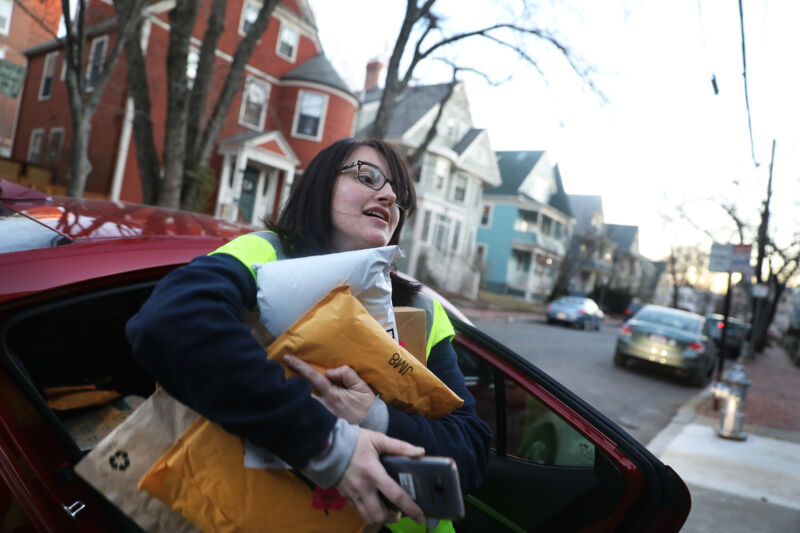
Locked gates, inclement weather, and bad selfies—all reasons drivers report that they were fired by the bots that apparently run human resources for Amazon’s Flex delivery program.
Millions of independent contractors are at the whim of a system that Amazon knows is problematic, according to a new report by Bloomberg. While serious early glitches have been worked out, significant issues remain, according to the article. Amazon is reportedly unconcerned about the hiccups and bad press that result so long as sufficient numbers of drivers are available to replace those whose accounts are mistakenly terminated.
“Executives knew this was gonna shit the bed,” a former engineer who designed the system told Bloomberg. “That’s actually how they put it in meetings. The only question was how much poo we wanted there to be.”
The e-commerce giant started Flex in 2015 to handle surges of packages and two-hour deliveries for its Prime Now service. Today, it also coordinates deliveries for Whole Foods grocery orders. (If you’re curious to hear details about how the system functions when it's working, Ars’ own Sam Machkovech went gonzo a few years ago and worked a shift as a driver.) During the pandemic, the Flex program became an increasingly important part of the retailer’s logistics program, so much so that it offered Flex drivers a bonus to work at least 20 hours in December 2020.Flex hirings, performance reports, and firings are all handled by software, with minimal intervention by humans. Drivers sign up and upload required documents via a smartphone app, through which they also sign up for shifts, coordinate deliveries, and report problems. It’s also how drivers monitor their ratings, which fall into four broad buckets—Fantastic, Great, Fair, or At Risk. Flex drivers are assessed on a range of variables, including on-time performance, details like whether the package is sufficiently hidden from the street, and a driver’s ability to fulfill customer requests.
Amazon refutes the idea that drivers have been unfairly treated. “We have invested heavily in technology and resources to provide drivers visibility into their standing and eligibility to continue delivering, and investigate all driver appeals,” Amazon spokesperson Kate Kudrna told Bloomberg.
Opaque system
Former Flex drivers interviewed by Bloomberg and driver reports posted on forums across the Internet reveal an opaque system that often leaves them guessing as to why their ratings dropped or why their accounts were terminated—effectively firing them from the job.
Neddra Lira, a former driver interviewed by Bloomberg, said her ratings tanked after she had to return packages to the warehouse when she found a nail in her tire. She managed to raise her rating to “great” over the next several weeks only to have her account terminated for violating terms of service. She appealed the termination, but Amazon didn’t budge.
Another driver Bloomberg spoke with, Stephen Normandin, had trouble delivering packages to Phoenix-area apartment complexes before dawn. The gates were still locked, the offices were closed, and package recipients weren’t answering their phones. In another apartment complex, an Amazon locker wouldn’t open for him. His rating also suffered in the wake of those problems, and he spent six weeks reviving it—only to be terminated days later because his rating had “dropped below an acceptable level.”
The reasons Amazon gives for firing Flex workers don’t always appear to match the true reason for the termination. One driver posting on reddit said they were terminated because, according to the Flex app, the selfies they took to verify their identity at the start of the shift didn’t match the driver’s license photo they uploaded when they set up the account. The driver wasn’t buying it, though, since in the shift they worked before being fired, packages the app assigned to them were not available at the Prime Now depot and thus were unable to be delivered.“The termination email I received this morning was sent at 1:17am, but at 1:06am, just eleven minutes before, I had also received one of those generic emails reminding me that I need to pick up all of my orders,” the person wrote. “I’m assuming this isn’t coincidence, and even though the termination email specifically states ‘images’ as the reason for termination, I’m attributing it to these ‘missed packages.’”
Facial recognition issues
Amazon started requiring selfies in 2019 so that multiple people wouldn’t share a single account. The practice may help prevent people from using other accounts to steal packages. But there are other drivers who use the practice for more legitimate purposes, including to deliver more packages faster, which can bump up their ratings, or to fulfill deliveries without racking up parking tickets.
Flex drivers’ forums are littered with posts from people complaining that their accounts were terminated because their selfies did not “meet the requirements for the Amazon Flex program.” The photos appear to be verified by image recognition algorithms. People who have lost weight or shaved their beards or gotten a haircut have run into problems, as have drivers attempting to start a shift at night, when low lighting can result in a poor-quality selfie.
Drivers who believe they’ve been unfairly terminated have ten days to petition to have their accounts reinstated, but in that time, they cannot work any shifts. If a driver loses the appeal, they can ask for arbitration, though it costs them $200. For many drivers, who make between $18–$30 per hour delivering for Flex, it’s simply not worth it. For Amazon, though, botched terminations don’t seem to be tempering interest in the Flex program. In May alone, the Flex app was downloaded 200,000 times, according to SensorTower.
reader comments
275